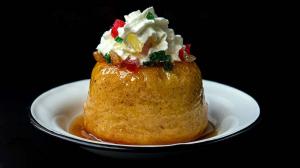A little crown-shaped yeasted brioche-like cake with a hole in the middle, that is baked then allowed to dry out and later soaked with a sweet aromatic syrup to which you add a strong alcohol and perhaps glaze it too so it could be shiny and then fill it up with pastry cream or just top it off with a flourish of whipped cream and then decorate it with candied fruits or soaked dried fruits … this is a BABA au WHATEVER ALCOHOL YOU LOVE for VALENTINE’S DAY !
Babas were not always soaked and flavored with a sweetened rum syrup, since different alcohols were added from the mid-18th century and on, to remoisten and sweeten cakes that had dried out and which allowed the cakes to absorb twice their dry weight in syrup and alcohol. Rum, but preferably a dark aged & spiced rum, has become the most common, but cognac or brandy is my preference, and why not whisky ?
In this recipe, we’re actually creating our own flavored syrup with an array of citrus juices and zests as well as warming spices like cinnamon, clove, nutmeg, allspice, ginger and vanilla.
Despite the fact that people rarely prepare this dessert at home, it’s actually quite easy and extremely practical because the little cakes should be prepared in advance and ideally left to dry out, to better absorb the reheated syrup and alcohol. The syrup is prepared in advance and the alcohol is added to the reheated syrup only after it’s removed from the stovetop. And the rest, like some pastry cream in the middle, if that’s what you like, and the whipped cream and dried or candied fruits on top, are decorative and provide a colorful contrast.
I’ve tested it with different approaches and it seems like I’ve figured it out how to make it the easiest to prepare, to understand as well as to make it practical. In the end, you are simply assembling the different parts that make this dessert what it is.
The full recipe is for 12 mini cakes even though I show you only 8 in the photos but it’s easy to half the recipe, if you only need 6.
The only difficulty would be in finding these little individual 90ml total volume savarin or mini-bundt molds that I have, made of silicone and actually used for making little soaps but any little individual, slightly cone-shaped tins or cupcake tins will also get the job done.
I add little notes and pointers to clear up any questions you may have and so that you have enough of everything for the assemblies.
HAPPY VALENTINE’S WEEKEND … :)























